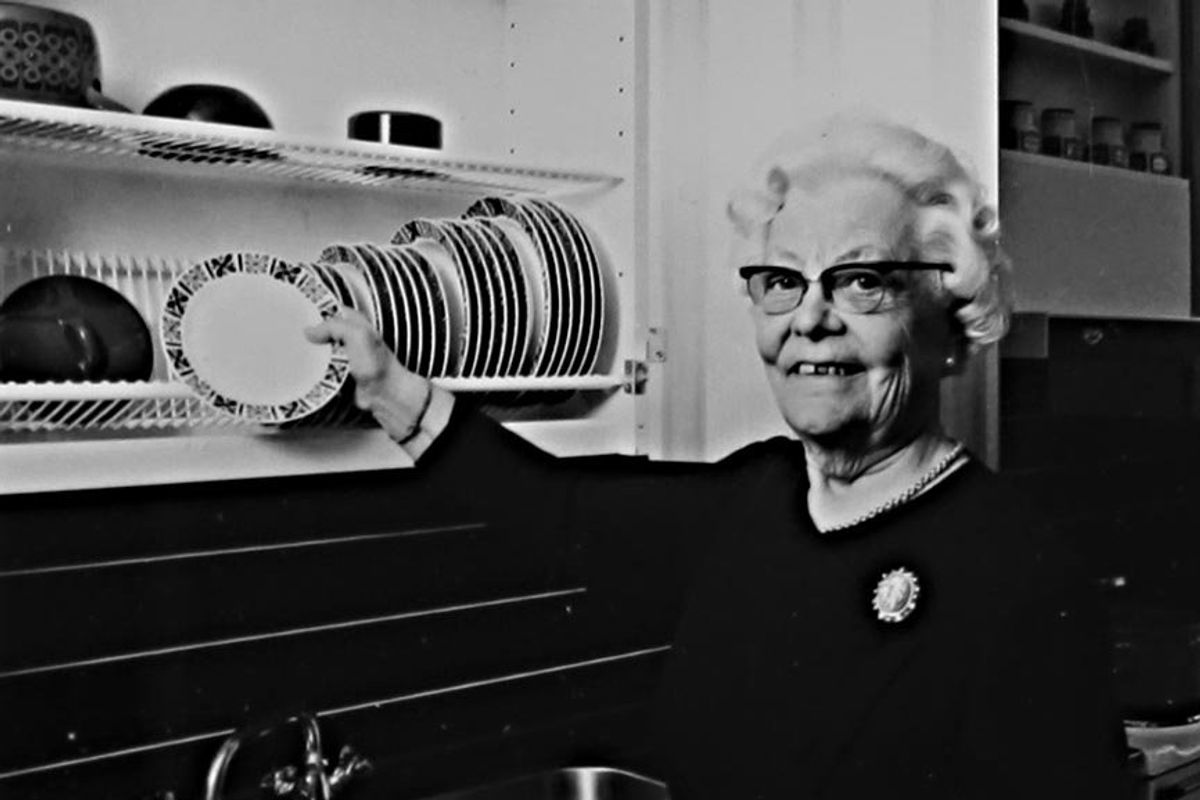Wall-mounted dish drying racks have suddenly become the new must-have item for family kitchens
Five reasons why America is falling in love with this old-school kitchen essential.
Maiju Gebhard with her dish-drying racks
Just like hemlines for jeans and living room paint colors, trends come and go like the wind. But sometimes, even trends steeped in pure logic that genuinely make life easier take a while to gain traction all around the world. Such is the case for the wall-mounted dish drying racks, which are finally becoming a staple in kitchens in the globe's last outlier—America.
While there had been earlier patents, it wasn't until the 1940s when Finnish inventor Maiju Gebhard popularized the idea of the wall-mounted dish drying rack, known in Finland as astiankuivauskaappi. The idea is simple: instead of a drying rack in your sink or on the kitchen counter, this one is mounted directly above the sink in a closed or open cabinet with an open-ended bottom, allowing water to drip, and plates, etc. to properly air dry.
In an article about Nordic inventions for 99 Percent Invisible (99pi), writer Kurt Kohlstedt notes that Gebhard's design, "in conjunction with the Finnish Association for Work Efficiency, was a huge success. Her basic design is widely used in Finnish kitchens to this day. Over time, older versions built with wood have been replaced by ones using metal wire and/or plastic."
In David Cad's TikTok video, he illustrates what it might be like for a "foreigner to see astiankuivauskaappi" for the first time. "Who else knows about this?" he jokes. His counterpart answers, "What? This is in like every Finnish home."
@davecad Tbh it's pretty awesome 😂 #suomitok #suomi #suomitiktok #fyp #ttsuomi #livinginfinland #finland #finnish #fypsuomi #astiankuivauskaappi
The video has garnered nearly half a million likes and has comments from all over the world.
An American writes, "I live in a New York City apartment and I would kill to have that much cabinet storage space."
One TikToker notes, "Come to Singapore. You'll find this in almost every home."
Many living in Europe also vouch for them. From Italy to Romania to Spain, people chime in to share that this has been the standard for quite some time. A person in Poland claims, "Very popular in Poland, with a tray under the cabinet to avoid drops on the counter."
In the Middle East, someone asks, "Is this a thing? It's a basic here in the Middle East." To that point, another adds, "It's in Saudi Arabia and we improved it by making it slide down so you can stack on the upper shelf and then slide it back up."
-dish-drying racks, kitchen, organization, inventions www.youtube.com, Letters from the Freezer
It has taken a while for the West to catch up on this invention, but it's finally happening and better late than never. It makes so much sense and here are a few reasons why:
More hygienic
On traditional counter or sink-based drying racks, moisture can get trapped, leading to unsanitary conditions. And you know who loves those? Bugs and bacteria. When the rack is raised up, the airflow is better, which results in a cleaner dish and all-around more hygienic kitchen.
Dries dishes faster
With more efficient airflow comes faster-drying dishes. It's just science.
Saves energy and money
If you're using a dishwasher to wash and dry your dishes, you're using (on average) about 1800 watts of energy per cycle. This isn't outrageous, but one can still save money and precious energy by skipping the appliance and washing and drying the old-fashioned way.
Looks clean and cool
Stacked plates and glasses on the countertop can make kitchens seem messy. This mounted drying system eases up the visual clutter and gives at least some illusion of organization.
Frees up space
When your kitchen countertop is littered with an old-fashioned drying rack, then it takes up much-need space for cutting limes or whisking up cake batter. Opening it up will make a lot of difference, both for your visual aesthetics and practical purposes.
If you're ready to take the leap and are looking for options, Wayfair has dishrack drainer shelves, that are sleek and useful.
Also, the Asieit over-the-sink dish drying rack seems popular and affordable. It's an alternative to actually mounting the rack, as it's placed over the sink with extra storage on top.
To take it a step further, a mounted utensil rack adds a bit of pizzazz to the kitchen and again, gives much needed extra space. While it's not a drying mechanism, per se, it could be used as one if a tray is placed underneath.

